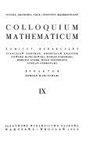复两平面格拉斯曼函数实超曲面上的Einstein-Weyl结构
IF 0.4
4区 数学
Q4 MATHEMATICS
引用次数: 0
摘要
. 研究了复两平面Grassmannian g2 (cm +2), m≥3中具有Einstein-Weyl结构的真实Hopf超曲面。首先证明了如果∇ξ θ = 0,具有闭Einstein-Weyl结构W = (g, θ)的实Hopf超曲面为(B)型,其中ξ表示该超曲面的Reeb向量场。其次,对于具有非消失测地Reeb流的Hopf超曲面,我们证明了不存在Einstein - Weyl结构W = (g, kη),其中k是一个非零常数,η是ξ的一形式对偶。最后,证明了具有两个闭Einstein-Weyl结构W±= (g,±θ)的实Hopf超曲面为(a)型或(B)型。本文章由计算机程序翻译,如有差异,请以英文原文为准。
Einstein–Weyl structures on real hypersurfaces of complex two-plane Grassmannians
. We study real Hopf hypersurfaces with Einstein–Weyl structures in the complex two-plane Grassmannian G 2 ( C m +2 ) , m ≥ 3 . First we prove that a real Hopf hypersurface with a closed Einstein–Weyl structure W = ( g, θ ) is of type (B) if ∇ ξ θ = 0 , where ξ denotes the Reeb vector field of the hypersurface. Next, for a Hopf hypersurface with non-vanishing geodesic Reeb flow, we prove that there does not exist an Einstein– Weyl structure W = ( g, kη ) , where k is a non-zero constant and η is a one-form dual to ξ . Finally, it is proved that a real Hopf hypersurface with two closed Einstein–Weyl structures W ± = ( g, ± θ ) is of type (A) or type (B). ,
求助全文
通过发布文献求助,成功后即可免费获取论文全文。
去求助
来源期刊

Colloquium Mathematicum
MATHEMATICS-
CiteScore
0.90
自引率
0.00%
发文量
61
审稿时长
6-12 weeks
期刊介绍:
Colloquium Mathematicum is a journal devoted to the publication of original papers of moderate length addressed to a broad mathematical audience. It publishes results of original research, interesting new proofs of important theorems and research-expository papers in all fields of pure mathematics.
Two issues constitute a volume, and at least four volumes are published each year.
 求助内容:
求助内容: 应助结果提醒方式:
应助结果提醒方式:


